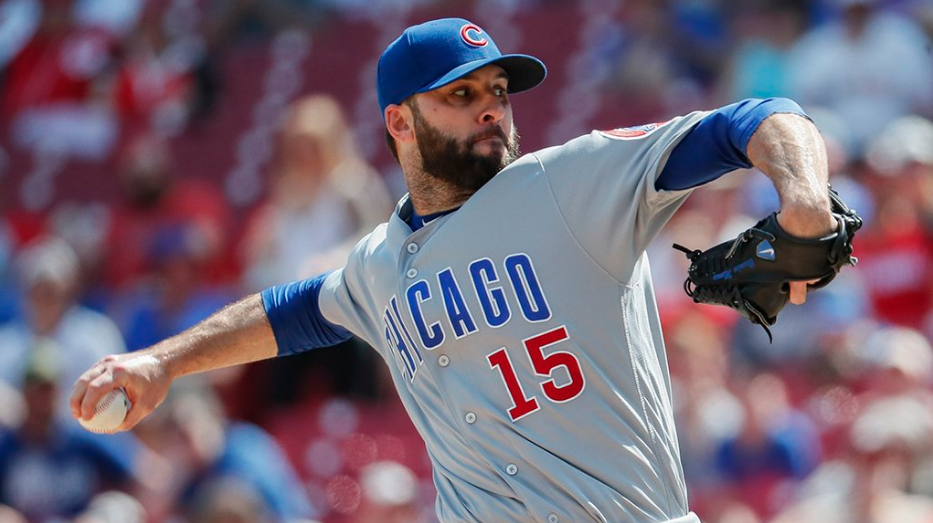Position: Relief Pitcher, Primary Closer
2018 Stats: 1.47 ERA, 1.08 WHIP, 2.92 FIP, 3.66 DRA, 0.4 WARP
Year in review: The Cubs knew the risk they were taking when they signed Brandon Morrow to be the team’s primary closer prior to the 2018 season. As a starter early in his career, the injury-prone righty made 30 starts in a season only once (2011), hadn’t pitched more than 55 innings in a season since 2013, and was converted to a full-time reliever in 2016. To say that his past medical history contained red flags would be an understatement.
However, the Cubs also knew that, if they could keep him healthy, the potential payoff would be huge. The team needed powerful shutdown arm in the back of their bullpen for 2018, a void created by Wade Davis’ departure for Colorado and Carl Edwards, Jr.’s inconsistent showing in the postseason. Morrow was coming off of a dominant run in 2017 as the set-up man for the Los Angeles Dodgers, a run which included four appearances against the Cubs in the NLCS in which he allowed a total of two baserunners. Morrow started 2017 in the minor leagues, but quickly became a revelation for Los Angeles, mowing hitters down primarily with a high-90s fastball and a wicked, high-80s slider. He struck out 29.4% of the batters he faced while walking only 5.3%.
Wanting to preserve that level of production, the Cubs came into 2018 with a clear plan in place for Morrow. He pitched on back-to-back days only five times in April and May, and only one of those occurrences could be classified as stressful, a 23-pitch outing in St. Louis on May 5th followed by a 14-pitch outing the following day. In addition to the limited innings, Morrow’s pitch usage had changed dramatically, presumably by design. His slider usage dropped from 23.3% in 2017 to 13.3% in 2018, likely in an attempt to limit the stress on his arm.
And for the first few months of the 2018 season, the plan appeared to be paying dividends. Through June 1st, Morrow had successfully converted 14 out of his first 15 save opportunities, was sporting an 0.93 ERA and was striking out 28.3% of batters. There were some signs that Morrow was benefitting from some sequencing and batted ball-related luck – his 89.5% strand rate was unsustainably high and hard contact rate allowed was up, but even allowing for some regression, Morrow was the dominant closer the Cubs had hoped for when they signed him.
Unfortunately, June 2nd is when things started to go downhill for Morrow. The Cubs were locked in an extra-innings struggle against the Mets when they exploded for six runs in the top of the 14th inning to take a 7-1 lead. As a part of that rally, Joe Maddon pinch-hit for reliever Luke Farrell, who had given the Cubs five scoreless innings to that point. Morrow was supposed to be unavailable, having pitched each of the previous two games, but Maddon called on him to get the final three outs with a six-run lead, which he did successfully.
Morrow continued to pitch until the All-Star break in mid-July, but did so with reduced velocity and effectiveness (2.61 ERA, 22.2% strikeout rate). After the break, Morrow was placed on the disabled list with biceps inflammation. The injury was originally believed to be minor, requiring only a few weeks of rest, but ended up keeping Morrow sidelined for the remainder of the season. After the season, Joe Maddon and Theo Epstein pointed to his June 2nd outing in New York, his third in three days, as a potential contributing factor to the injury.
Looking ahead: On December 6th, it was reported that Morrow had arthroscopic surgery on his elbow after the season. This news came as a surprise, considering previous reports that the injury could be managed through rest alone. Morrow is planning to begin throwing in February, but will likely miss the beginning of the 2019 season.
Given his past, the 2018 season is exactly what we should have expected from Morrow, and what we should expect for 2019 as well. When healthy, Morrow has the electric stuff to put together stretches of dominance, and will be a real asset to the Cubs’ bullpen. However, he can’t be relied upon for consistent innings throughout the year. Look for the Cubs to manage his innings very careful this season, with an eye towards keeping him on the mound for high-leverage innings next October.
Lead photo courtesy @Cubs on Twitter
